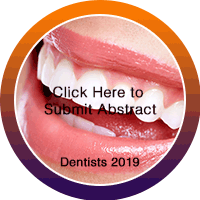
Abir Abu Subeh
Dr.Fares Kablan Oral and Maxillofacial Center, Israel
Title: The use of cortical bone wedges from the mandibular ramus
Biography
Biography: Abir Abu Subeh
Abstract
Purpose: Autogenous bone still considered the gold standard in bone augmentations prior to implants insertion in atrophic ridges. However if large amounts of bone grafts are needed to augment multiple edentulous atrophic segments, extraoral donor sites may be mandatory. The aim of this report is to introduce the Fares Wedge Technique, as a new bone augmentation method that can augment multiple edentulous ridges with intraoral cortical bone grafts.
Methods: Patients with moderate to severe ridge atrophy in different regions of the jaws were treated over 6-years period with the wedge technique(WT). Patients received panorex immediately after the surgery, and they were examined clinically and radiographically (periapical) every 2 weeks. At 4 months, computed tomography was performed to evaluate the bone gain. Reentry was performed after 4 to 5 months to evaluate the new bone volume and quality and to insert implants. At this stage specimens for histologic examination were also obtained.
Results: 39 augmentation site in 22 patients (15 women, 7 men : mean age 47 years) were followed 12 to 52 months The healing process was uneventful, with minimal morbidity. The success rate was 95%, the bone gain average was 3-6 mm vertically and 3-9 mm horizontally. In two patients the graft was partially exposed and treated with shaving and rounding the exposed wedges, but the augmentations were saved. In one case the majority of the bone graft was lost. At 38 sites the patients had successfully received 113 implants.
Conclusions: wedge technique can augment multiple segments of atrophic
ridges with small amount of autogenic graft. The bone volume that achieved was satisfying, especially that the majority of the augmented areas were at posterior mandibular defects.
Publications
1- Chiapasco M. Casentini P, Zaniboni M. Bone augmentation procedures in implant dentistry. Int J Oral Maxillofac Implants 24. Suppl (2009): 237-259.
2- Esposito M, Grusovin MG, Coulthard P, Worthington HV. The efficacy of various bone augmentation procedures for dental implants: A Cochrane systematic review of randomized controlled clinical trials. Int J Oral Maxillofac Implants 21 (2006): 696-710.
3- Rabelo GD, de Paula PM, Rocha FS, et al. Retrospective study of bone grafting procedures before implants placement. Implant Dent 19.4 (2010): 342-50.
4- Haggerty CJ, Vogel CJ. Fisher GR. Simple bone augmentation for alveolar ridge defects. Oral Maxillofac Surg Clin N Am 27(2015): 203-226.
5- Boyne PJ, Herdford AS. An algorithm for reconstruction of alveolar defects before implant placement. Oral Maxillofac Surg Clin North Am 13 (2001): 533-541.

